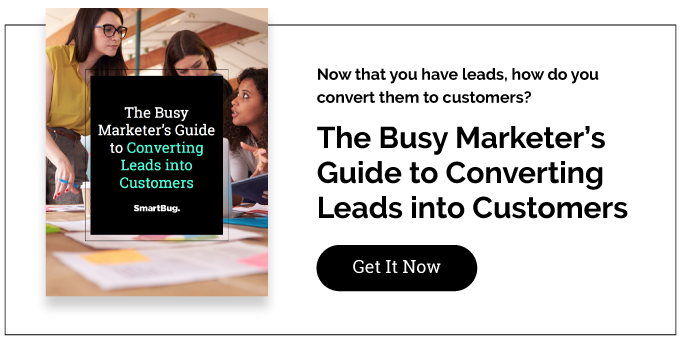
The 2 Easiest Ways to Measure Your Qualified Leads
August 15, 2016
Very little feels quite as good in the world of inbound marketing as launching a new piece of premium content and watching those form submissions come rolling in. After all, once you’ve been involved in inbound marketing for a few months, you know that success is measured by three core figures: website traffic, conversions, and revenue. Now, while both website traffic and revenue correspond directly with key performance indicators (KPIs), website visitors and customers, respectively, how does one measure the success of conversions?
Leads. Contact conversions. Form submissions.
But unfortunately for you, and possibly that landing page’s form submissions, not all leads are created equal. So while that latest landing page may have led to 100 form submissions, not all of those submissions carry equal weight. And in order to successfully qualify leads, we must first understand the different types that exist.
What Is a Lead?
In its simplest form, a lead is a contact that was added to your database when that contact submitted a form. That person who filled out your Contact Us form and is now in your Contacts database—he or she’s a lead. That person who registered for your upcoming webinar and is now in your Contacts database—he or she’s a lead. That contact who was imported from Salesforce and now lives in your HubSpot Contacts database—not a lead.
Essentially, leads are contacts who were interested enough in your organization to provide you with their information in an exchange. Be it for a resource or initiating contact, these people wanted something from you. However, just because someone wants to download a resource from your website does not mean that he or she is a valid, or qualified, prospect. Which brings us to the next steps of lead qualification: the marketing qualified lead (MQL) and the sales qualified lead (SQL).
What Is a Marketing Qualified Lead (MQL)?
An MQL, unfortunately, is still not quite ready to make a sale. However, because of the information that you have gathered from him or her, you can tell that he or she is more engaged and closer to the point of sale than a standard lead.
What Is a Sales Qualified Lead (SQL)?
An SQL is ready for a sale and is thus worthy of a direct sales follow-up. These are the most valuable of all the leads, for not only have they indicated that they are interested in your company and its products/services, but they have indicated that they are ready to buy.
The Importance of Demographics and Psychographics
Now that you understand the different lead qualifications that exist, it’s time to get qualifying, right? Well, not quite yet. Unfortunately, while these categories of lead qualification will not ever change, not all companies can qualify leads in the same way. Before you can begin to qualify your leads, you need to take a look back at your buyer personas.
Which details and psychographics truly cause them to be considered an ideal customer? Is it their job title? Their company’s total revenue? The start date of their organization’s buying cycle? While these demographic details most definitely contribute to how they are perceived by your company’s sales team, they are not the only details that matter.
Their behaviors matter as well. What do I mean by this? I mean, a contact who has visited your website every day for the past month is most likely more interested in your organization than a contact who viewed your website once three months ago. Your contacts’ behaviors matter. Perhaps your sales team also knows that it has a 95 percent lead-to-customer conversion rate after a contact views a demo. Therefore, those contacts who view the demo could be considered more sales-ready than those who have only subscribed to your blog.
Once you understand which behavioral and demographic details most clearly indicate either the sales-readiness or idealness of certain contacts, you can move forward in the lead qualification process. I have two favorite methods to measure, or qualify, leads:
HubSpot’s Smart Lists
If you’re unaware of Smart Lists, let me just say that I think they are one of the best tools in HubSpot. They allow you to essentially cast a net over not only your existing contacts, but any new contacts that come in (regardless of the source), and create a list based on criteria that you provide.
Let’s say you want to create a list of all leads whom you have defined as SQLs. For all intents and purposes, we’re going to keep this simple and say that SQLs have been defined as having “director” in their job title and have filled out a specific bottom-of-the-funnel form. Once the filters are set and the list is activated, you are good to go. From that point on, as soon as any contact meets those conditions, he or she will be added to the list.
Pro Tip: Create an internal notification workflow in order to notify your sales team when this happens.
HubSpot’s Lead Scoring
HubSpot’s lead scoring allows you to take the factors and behaviors that your company believes to be most important and, essentially, score each and every contact in your system. Personally, what helps me is to think of all of your leads like an old-fashioned mercury thermometer that measures from 0 to 100 degrees Fahrenheit. At the bottom, it’s cold. Around 75 degrees, it’s warm, but up at 100—that’s where it’s hot.
Using lead scoring, the weight that you assign to different values and behaviors of leads contributes to how quickly they jump up (or down) that measuring stick. Thus, it takes into account all factors all at once, allowing you to see the bigger-picture view of your leads.
If you designate an SQL as a 90 or above, you know that if you have 10 leads at a score of 90 or above, all of the positive and negative attributes that you have chosen to measure have already been counted. Lead scoring essentially does the heavy lifting of profiling for you. And with the use of a corresponding Smart List (lead score = 90 or above) and an internal notification workflow, it too can keep you notified whenever a truly qualified lead appears in your contact database.
Once Your Leads Are Qualified...
Whether your leads fall into a qualified lead Smart List or hit that particular lead score mark, you have successfully qualified your leads. The next steps are to categorize them officially through the establishment of lifecycle stages and reach out to those leads who are ready for contact.

About the author
Kristen Patel was formerly a CRO Strategist at SmartBug Media. She joined the team with years of inbound agency experience under her belt, and two Bachelors of Science in International Marketing. While technically based in Maryland, she's often on the move (2018 will bring her to Guatemala, Belize, Mexico... and that's only through February!). Read more articles by Kristen Patel.







-2.png?width=800&length=800&name=Blog%20header%20image%20(1)-2.png)